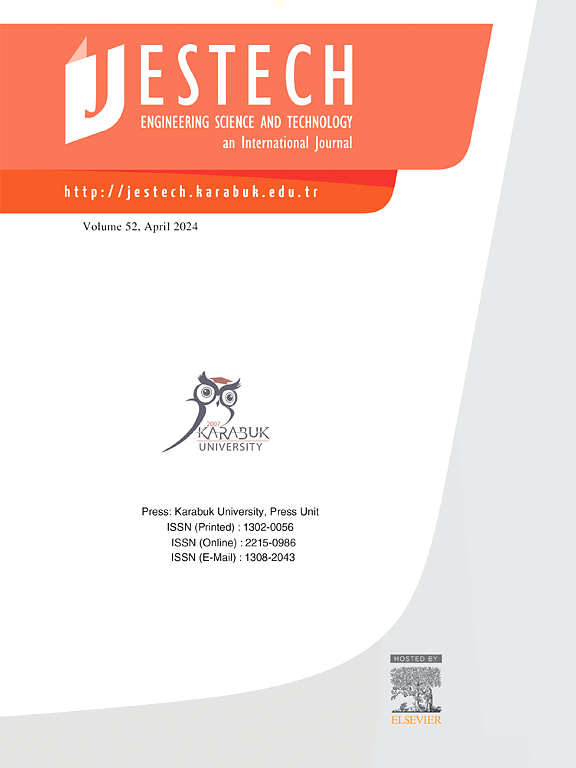Grey Wolf Algorithm-Based source size and location determination method for capacity expansion planning in power systems
IF 5.1
2区 工程技术
Q1 ENGINEERING, MULTIDISCIPLINARY
Engineering Science and Technology-An International Journal-Jestech
Pub Date : 2025-01-01
DOI:10.1016/j.jestch.2024.101934
引用次数: 0
Abstract
Expansion of power generation capacity within power systems is crucial for improving system reliability and efficiency. The main objective of the process is to optimize the power generation capacity to appropriately meet current and future load demands. In this study, the stability issues that arise in power systems due to the increment in load power, overloads on transmission lines, changes in bus voltages and the effects of available generation resources on these dynamics are investigated. In particular, the issues such as overloads on transmission lines, increases in the loading rates of generation resources and decreases or increases in bus voltages are examined. The size and location of new sources to be added to the system have great importance in order to overcome these issues. IEEE 39 bus test system is used, and the power system is modeled in the DIgSILENT platform. Integrated simulations were performed by integrating the DIgSILENT and Python programming. The simulation scenarios are created by increasing the load power located at various buses. The scenarios and system configurations were automatically tested through Python scripts, allowing a broader perspective of the effects of line loading, bus voltages and generation resources on system performance. The possible solutions without optimization are obtained in the first stage with the standard IEEE 39 bus test system. Considering the source size and location, line loading limits, generator capacity, and bus parameters, the Grey Wolf optimization algorithm determines the optimum solution for the capacity expansion. Thus, an effective method is proposed for power system planning. According to the optimization results the IEEE 39 bus test system is modified by increasing capacity of current sources or adding new sources. The obtained solutions with the proposed method are simulated, and the system performance in terms of line loading, generator loading, and bus voltage is tested. The results reveal that the proposed method provides the optimum capacity expansion solutions to eliminate the adverse effects of increment in load power.
求助全文
约1分钟内获得全文
求助全文
来源期刊

Engineering Science and Technology-An International Journal-Jestech
Materials Science-Electronic, Optical and Magnetic Materials
CiteScore
11.20
自引率
3.50%
发文量
153
审稿时长
22 days
期刊介绍:
Engineering Science and Technology, an International Journal (JESTECH) (formerly Technology), a peer-reviewed quarterly engineering journal, publishes both theoretical and experimental high quality papers of permanent interest, not previously published in journals, in the field of engineering and applied science which aims to promote the theory and practice of technology and engineering. In addition to peer-reviewed original research papers, the Editorial Board welcomes original research reports, state-of-the-art reviews and communications in the broadly defined field of engineering science and technology.
The scope of JESTECH includes a wide spectrum of subjects including:
-Electrical/Electronics and Computer Engineering (Biomedical Engineering and Instrumentation; Coding, Cryptography, and Information Protection; Communications, Networks, Mobile Computing and Distributed Systems; Compilers and Operating Systems; Computer Architecture, Parallel Processing, and Dependability; Computer Vision and Robotics; Control Theory; Electromagnetic Waves, Microwave Techniques and Antennas; Embedded Systems; Integrated Circuits, VLSI Design, Testing, and CAD; Microelectromechanical Systems; Microelectronics, and Electronic Devices and Circuits; Power, Energy and Energy Conversion Systems; Signal, Image, and Speech Processing)
-Mechanical and Civil Engineering (Automotive Technologies; Biomechanics; Construction Materials; Design and Manufacturing; Dynamics and Control; Energy Generation, Utilization, Conversion, and Storage; Fluid Mechanics and Hydraulics; Heat and Mass Transfer; Micro-Nano Sciences; Renewable and Sustainable Energy Technologies; Robotics and Mechatronics; Solid Mechanics and Structure; Thermal Sciences)
-Metallurgical and Materials Engineering (Advanced Materials Science; Biomaterials; Ceramic and Inorgnanic Materials; Electronic-Magnetic Materials; Energy and Environment; Materials Characterizastion; Metallurgy; Polymers and Nanocomposites)
 求助内容:
求助内容: 应助结果提醒方式:
应助结果提醒方式:


